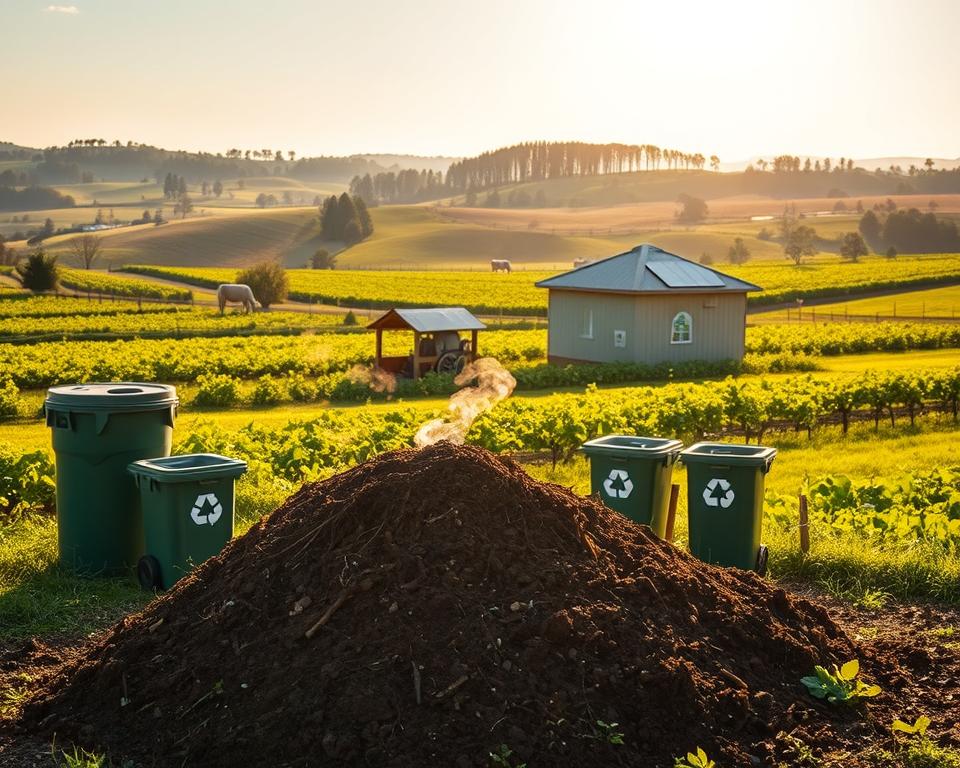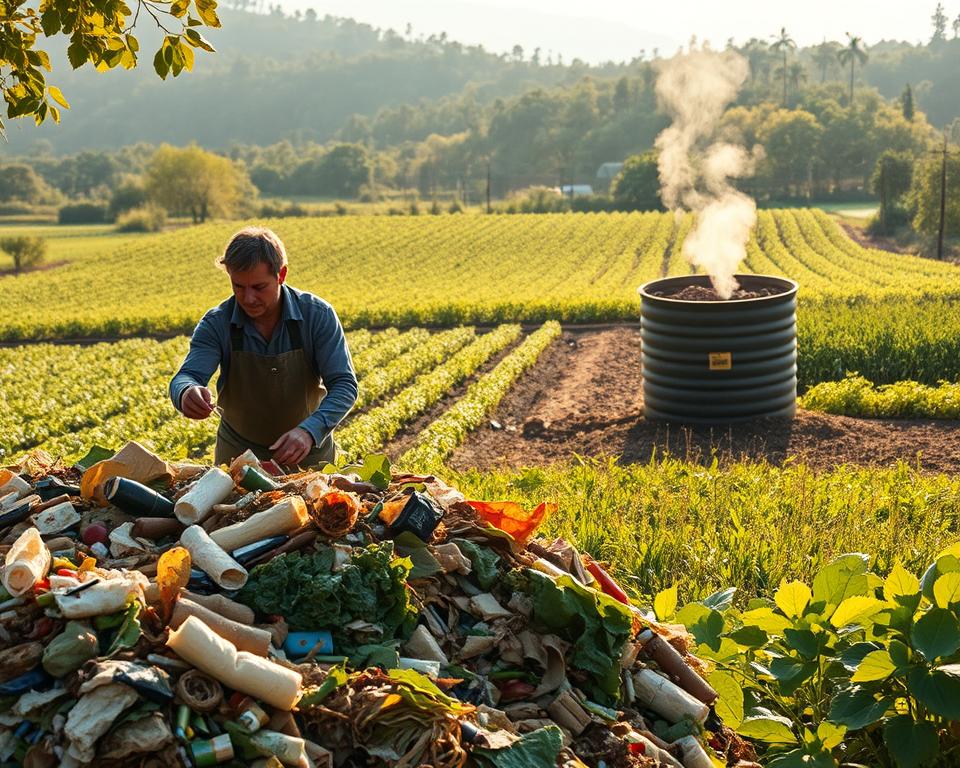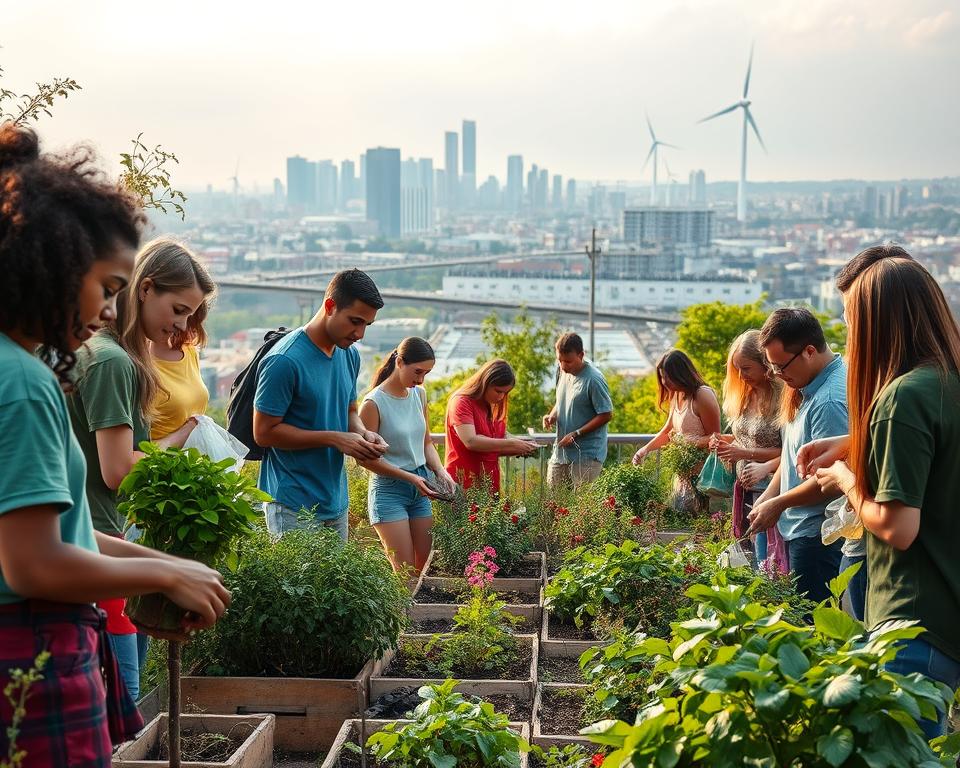Farmers globally produce massive amounts of waste, from crop leftovers to plastic packaging. Yet, reducing waste turns these materials into valuable assets. By focusing on waste reduction, farms can lower costs, safeguard ecosystems, and enhance productivity. It’s estimated that one-third of all food produced worldwide never reaches consumers, instead ending up in landfills where it decomposes and releases methane—a potent greenhouse gas.
Composting transforms these scraps into nutrient-rich soil. Recycling plastics and water further reduces landfill reliance. Farm waste management strategies also harness energy through anaerobic digestion, converting manure into biogas to power farms sustainably. Implementing practices like reusing water four times on dairy farms and donating surplus crops contributes to a cleaner, more efficient operation.
Effective waste reduction is not only eco-friendly but also financially beneficial. Composting reduces landfill costs and enriches soils, while recycling plastics lowers material expenses. The EPA highlights that 8% of global emissions come from food loss, emphasizing the need for farm-level action. Small actions, such as tracking waste flows or collaborating with local recyclers, collectively make a significant difference.
Farmers adopting these practices enjoy long-term savings and meet regulatory requirements like the Conservation Stewardship Program. Every decision, from using smart sensors to implementing crop rotation, converts waste into valuable resources.
Key Takeaways
- Composting food scraps can reduce greenhouse gas emissions equivalent to 600,000 cars yearly.
- Recycling farm plastics and organic waste cuts costs while improving soil health.
- Methane from landfills contributes 8% of global greenhouse gas emissions.
- Water reuse systems save resources and lower operational expenses.
- EPA guidelines and state incentives support farms adopting sustainable waste practices.
Understanding the Importance of Waste Reduction in Agriculture
Farms face a constant battle to increase productivity while being environmentally responsible. Sustainable waste management is not just a choice; it’s a must. By focusing on waste minimization, farmers not only protect the environment but also save money and strengthen their communities.
Environmental Benefits
Food waste in landfills produces methane, a gas 80 times more harmful than CO2. By adopting sustainable practices, farmers can significantly reduce emissions. In fact, 8-10% of global emissions come from wasted food. Composting organic waste also enhances soil health, reducing erosion and chemical runoff. Here’s how it impacts us:
| Statistic | Impact |
|---|---|
| 1B+ tonnes of wasted food annually | Drives climate change |
| 40% of global produce lost | Strains ecosystems |
| 1 in 10 people malnourished | Highlights systemic inefficiencies |
Economic Savings
Waste minimization can significantly increase profits. Restaurants that save food waste see a $7 return for every $1 invested. Farms can cut disposal costs and use materials more efficiently, replacing expensive fertilizers with composted scraps. A U.S. family can save $1,800 a year by reducing food waste. Farmers can achieve similar savings through better storage and harvest planning.
Community Impact
When farms lead in sustainability, local communities benefit. Reduced water contamination improves public health. By donating surplus produce to food banks, farms gain goodwill and meet regulatory standards. This fosters partnerships with schools and NGOs, creating a cycle of mutual support.
Composting: A Sustainable Solution for Organic Waste
Composting turns organic waste into a valuable resource, fitting perfectly with eco-friendly practices and efficient resource usage. It helps farmers by diverting food scraps and farm byproducts from landfills. This action reduces methane emissions and improves soil health.
“Increasing global composting could reduce emissions by 2.1 billion tonnes by 2050.”
What Can Be Composted?
- Crop residues: Stalks, leaves, and husks
- Livestock manure and bedding materials
- Kitchen scraps like fruit/vegetable peels
- Yard trimmings and straw
How to Start Composting on Your Farm
- Select a dry, shaded site close to water access
- Layer green waste (nitrogen-rich) with browns (carbon-rich)
- Moisten the pile to the consistency of a wrung-out sponge
- Turn the pile weekly using a pitchfork to aerate
Tips for Successful Composting
Ensure a carbon-to nitrogen ratio of 25:1 for quicker decomposition. Steer clear of adding meat, dairy, or oily foods to prevent odors. Use a thermometer to check internal temperatures—aim for 130°F–160°F to kill pathogens. Also, consider partnering with local recycling facilities to manage large volumes efficiently.
Compost enhances soil structure, lowers fertilizer costs, and meets regulations like South Africa’s goal to divert 50% of organic waste by 2025. By embracing these practices, farms can reduce disposal costs and foster healthier ecosystems.
Recycling Practices for Farm Materials
Effective waste disposal methods begin with identifying recyclable items. Plastics like mulch films and irrigation tubing can be recycled into new products. Metals, including fencing or equipment parts, also have recycling options, reducing landfill waste. Cardboard, glass, and pesticide containers must be handled with care to prevent contamination. Farmers can learn more about sorting these materials to enhance recycling efforts.
Types of Materials Suitable for Recycling
- Plastics: Agricultural plastics must be clean and dry for recycling programs.
- Metal: Scrap metal can be sold to recyclers or reused on-site for repairs.
- Packaging: Pesticide containers need triple-rinsing before disposal to protect soil and water quality.
Setting Up a Recycling Program
Start by setting up labeled bins for different materials. Train staff to sort items like bale wraps and silage bags correctly. Partner with local recyclers for regular pickups of plastics and metals. Use clear signage and conduct regular audits to keep the program running smoothly.
Partnering with Local Recycling Facilities
Look for facilities certified by the EPA to handle agricultural waste. Take-back programs from manufacturers, like those for greenhouse covers, help in reducing environmental impact. Ensure materials are transported safely to avoid spills or damage.
Reuse Ideas for Farm Equipment and Supplies
Transform discarded materials into valuable assets with smart reuse tactics. Adopting waste reduction strategies like repurposing and swaps helps farms cut costs and boost sustainability. These environmentally conscious actions turn old items into tools that serve new purposes.
Begin by repurposing worn tools. Old gates can become garden trellises, while feed troughs serve as flower planters. Baling wire fixes fences, and burlap sacks become mulch or reusable bags. Repurposed tires make durable retaining walls, saving 40-60% compared to buying new materials. Street sweeper brushes can become animal scratchers, cutting costs by 70-80% over new equipment.
- Tool carts: Brands like Milwaukee and DeWalt offer mobile storage solutions built from reclaimed wood or scrap metal.
- Shed upgrades: Modular wall systems organize tools, while conveyor belts become durable feed bunks. Billboard tarps repurposed as hay covers save 80-90% over new options.
“Texas farmers reuse over 50 industrial materials, slashing costs by 30% while boosting animal welfare.”
Organize a farm swap day to exchange unwanted items. Invite neighbors to trade tools, seeds, or machinery parts. This environmentally conscious action reduces landfill waste and strengthens community ties. Upcycling also boosts farm efficiency—repurposed pallets make free shelving, and PVC pipes become DIY tool organizers.
Upcycling saves resources and money. Waste reduction strategies like these cut material costs while showcasing eco-friendly practices. By thinking creatively, farms can turn trash into treasure, proving sustainability and profitability go hand-in hand.
Implementing Zero Waste Principles
Zero waste farming reimagines how farms handle resources, aiming to eliminate waste through thoughtful design. This approach, championed by groups like the Zero Waste International Alliance (ZWIA), prioritizes the five Rs: Refuse, Reduce, Reuse, Recycle, and Rot. By 2003, ZWIA formalized these principles, creating a roadmap for farms to cut landfill reliance and pollution.
What is Zero Waste Farming?
Launched in the 1970s, this philosophy seeks to keep materials in use indefinitely. Unlike traditional sustainable waste management, it focuses on systemic changes. For example, composting replaces synthetic fertilizers while reducing landfill methane—a greenhouse gas 20x more potent than CO₂. The ZWIA’s seven-step hierarchy guides farmers to prioritize prevention over disposal.
Steps Toward a Zero Waste Farm
- Conduct a waste audit to identify top contributors like packaging or spoiled produce.
- Adopt the 5 Rs: Refuse single-use plastics, reduce overproduction, and reuse containers.
- Partner with recyclers for materials like pesticide containers and cardboard.
- Track progress using digital tools to adjust strategies monthly.
The Role of Technology in Zero Waste Practices
Tools like precision irrigation systems cut food waste by 30% by optimizing water use. Anaerobic digesters turn manure into energy, while apps like FarmLogs help farmers monitor crop yields to avoid overproduction. Even small tech like compost thermometers ensure proper decomposition, aligning with reducing waste goals.
| Traditional Farming | Zero Waste Approach |
|---|---|
| Single-use plastics | Reusable containers |
| Disposing of crop residues | Composting for soil health |
| Manual waste tracking | Digital audit tools |
Landfills are the 3rd largest methane source in the U.S., trailing only energy production and livestock.
Start small: Begin with composting kitchen scraps or auditing packaging suppliers. Every adjustment moves farms closer to circular systems that benefit both the environment and budgets. With global movements like Zero Waste France leading advocacy, adopting these strategies can transform how farms handle resources for generations.
Reducing Plastic Use on the Farm
Farmers aiming for waste minimization can opt for eco-friendly alternatives to plastics. Biodegradable mulches, such as coconut coir, not only reduce plastic usage but also enhance soil health. Winstrip Trays, designed to last up to 10 years, minimize the need for frequent replacements. Paper mulches, certified for organic farms, eliminate the risk of synthetic residue contamination.
“By 2025, 100% of plastic packaging must be recyclable or compostable.” — UK Plastics Pact
Alternatives to Plastic
- Coconut coir mulch: retains moisture longer than plastic film
- Bamboo-based pots degrade naturally after planting
- Steel baling twine replaces plastic twine in hay production
Best Practices for Minimizing Plastic Waste
Implementing efficient plastic storage systems can significantly increase reuse. Regular equipment maintenance extends tool lifespan. Collaborating with recyclers like Cleanfarms ensures proper disposal of agricultural plastics. Canada’s 25% plastic collection rate highlights the need for better sorting practices.
| Material | Recycling Rate | Storage Limit |
|---|---|---|
| Agricultural plastics | 10% | 3 years for recyclables |
| Non-recyclable waste | N/A | 1 year max storage |
Incentives for Sustainable Practices
US farmers adopting efficient resource usage can access USDA grants. Tax deductions are available for farms reducing plastic inputs by 30%+. Over 60 countries now offer subsidies for biodegradable packaging adoption.
Scotland’s 2019 ban on plastic burning reflects a global trend towards stricter regulations. Producers using 4+ layers in silage wrapping meet safety standards while significantly reducing plastic use. Silage pits are 40% less expensive than bale systems, conserving resources.
Engaging Employees in Waste Reduction Efforts
Creating a sustainable culture begins with each team member. When farm workers grasp their part in waste reduction, they become key players in resource conservation and efficiency enhancement. Training must be practical and inclusive, employing tools like visual aids or group sessions.
Training and Awareness Programs
Begin with the fundamentals of sorting recyclables and composting. At PG Tips, such training cut paper waste by 10 tons annually, saving $57,000. Introduce environmentally conscious actions through examples: switching to reusable mugs instead of disposable cups minimizes single-use plastics. Combine training with events like Earth Day celebrations to sustain enthusiasm.
Creating a Waste Reduction Task Force
Establish a team of volunteers to generate innovative solutions. A mason jar challenge—tracking waste in jars—encourages teams to compete while reducing waste. Utilize color-coded bins with clear labels to enhance participation. Daily huddles can highlight small victories, such as Subway’s bell pepper trimming efforts saving 2 lbs per case.
Recognizing Employee Contributions
- Host monthly awards for teams achieving recycling targets
- Share success stories in newsletters
- Offer incentives like extra PTO for Earth Day volunteering
Celebrating achievements keeps staff engaged. When employees witness their efforts reducing waste and saving costs, they are more inclined to embrace sustainable practices over time.
Benefits of Collaborating with Local Organizations
Small farms often struggle with limited resources when trying to reduce waste. Working with local groups can significantly boost efforts to reduce environmental impact and strengthen community bonds. Such collaborations provide access to shared knowledge, funding, and technology. These are crucial for implementing eco-friendly practices on a budget.
Building Relationships with Environmental Groups
- Connect with nonprofits like LJP Waste Solutions, which partners with farms in Southern Minnesota to boost recycling rates.
- Engage local schools for educational programs, teaching youth about composting and waste audits using EPA tools.
- Join agricultural extension services for grants and training in circular economy models.
Joint Initiatives for Waste Reduction
Create projects that merge resources and expertise:
- Community Composting Networks: Share infrastructure with neighbors to turn farm waste into soil amendments.
- Food Recovery Programs: Donate surplus produce to food banks, reducing the 92 billion pounds of annual U.S. food waste.
- Educational Workshops: Host events with local governments to teach neighbors about eco-friendly practices like upcycling materials.
Case Studies of Successful Collaborations
| Organization | Project | Impact |
|---|---|---|
| LJP Waste Solutions | Regional Recycling Partnership | Reduced landfill use by 30% in 2 years |
| Minnesota Farmers Collective | Food Waste-to-Compost Initiative | Prevented 1.2 million pounds of food waste in 2023 |
These partnerships also cut greenhouse gas emissions linked to wasted food (8–10% globally). By aligning with neighbors, farms turn challenges into opportunities for innovation and community growth.
Utilizing Smart Technology for Waste Management
Farmers are embracing smart technology to revolutionize waste disposal methods and enhance waste reduction strategies. Innovations such as IoT sensors and AI-driven systems are providing practical solutions for waste tracking and optimization. These advancements are transforming farms into cleaner, more efficient environments.
Overview of Innovative Solutions
Emerging tools are reshaping how farms manage materials:
- HomeBiogas systems: Convert organic waste into biogas using anaerobic digestion.
- AI sorting robots: Increase recycling efficiency by identifying and categorizing materials 24/7.
- Solar-powered compactors: Expand capacity up to five times, reducing collection trips.
Monitoring Waste Generation with Tech
Data-driven tools help pinpoint inefficiencies:
| Technology | Benefit |
|---|---|
| IoT sensors | Track fill levels in real-time, cutting unnecessary collections. |
| AI analytics | Optimize collection routes to lower fuel use by up to 30%. |
| Smart bins | Reduce overflow by alerting teams when bins are full. |
Case Studies of Smart Farms
Real-world examples show measurable impact:
A Midwestern dairy farm installed methane-capturing digesters, reducing emissions by 40%. Another vineyard in California used IoT sensors to cut collection trips by 25%, saving $12,000 annually. These farms demonstrate the value of investing in technology.
Smart systems aren’t limited to large operations. Even small farms can start with solar compactors or recycling apps. This marks the beginning of their journey toward smarter waste reduction strategies.
Measuring Waste Reduction Progress
Tracking waste reduction goals is crucial for farms aiming at sustainability. Without clear metrics, it’s challenging to gauge if efforts are effective. Establish targets, such as reducing paper waste by 20% in six months or composting 80% of organic materials by year-end.
Setting Key Performance Indicators (KPIs)
Start by establishing a baseline: monitor monthly waste volumes or waste per employee. Metrics like cost savings or greenhouse gas reductions are essential. Bell Atlantic’s example shows how data can lead to significant savings, reducing waste by 2.9 million pounds and saving $6 million.
The EPA’s WasteWise program demonstrates the importance of tracking efficient resource usage. It reveals which strategies yield the most cost savings.
- Set measurable goals: e.g., “reduce landfill use by 30%.”
- Track material-specific data (plastic, organic, paper).
- Include financial metrics like disposal cost reductions.
Regular Waste Audits
Perform audits every quarter to identify trends. Simple actions like waste sorts or reviewing purchasing records can pinpoint issues. Employee surveys help determine if recycling education is effective. The California CIWMB’s database provides benchmarks for comparison.
Sharing Results with Stakeholders
Share progress reports with staff, buyers, and communities. Highlight achievements like reaching a 50% recycling rate. Use charts to illustrate cost savings or emissions reductions. The WasteWise program emphasizes the importance of clear data in garnering support for future initiatives.
Adjust strategies based on audit findings. Even small improvements, like optimizing composting systems, can lead to significant gains over time. Consistent tracking transforms data into actionable steps, proving sustainability and profitability are intertwined.
The Future of Waste Reduction in Agriculture
As agriculture evolves, sustainable waste management will shape how farms operate. Innovations and policies are creating pathways for farmers to reduce environmental impact while staying competitive.
Emerging Trends and Technologies
New tools like the HomeBiogas system and Pearl® technology turn waste into resources. AI-driven waste sorting and regenerative practices, such as those highlighted by the Rodale Institute, offer ways to cut emissions. With 121,213 global patents since 2001, tech like Aqua2™N shows how nutrient recovery can boost efficiency. These advances align farms with climate goals while improving soil health.
Policy Changes and Their Impact
California’s SB1383 law and programs like Produce & Reduce—run by Windset Farms and Andrew & Williamson—prove policies can drive progress. Such initiatives reduced landfill use and cut costs, showing how farmers can adapt. Future rules may limit plastics or tax emissions, but programs like these provide models for compliance and innovation. The shift toward regenerative methods also addresses agriculture’s 33% share of global greenhouse gases.
How Farmers Can Prepare for the Future
Adopting tech like WASSTRIP® or joining partnerships can help farms stay ahead. Staying informed on trends like struvite recovery or biodegradable packaging keeps operations agile. Training teams, like the 50+ participants in California’s program, builds skills to meet evolving standards. By prioritizing sustainable practices now, farmers can reduce costs, secure resources, and meet future demands for eco-friendly agriculture.
FAQ
Why is waste reduction important for farms?
What are some effective waste reduction strategies in agriculture?
Can I compost animal manure on my farm?
How can I start a recycling program on my farm?
What are some creative ways to reuse old farming tools?
What does zero waste farming entail?
What alternatives exist to plastic in agriculture?
How can I engage my employees in waste reduction efforts?
What benefits do farms gain by collaborating with local organizations?
How is technology advancing waste management in agriculture?
How can I measure the success of my waste reduction efforts?
What future trends should farmers be aware of in waste management?

Chris King is a writer at InfoTrendor, a platform dedicated to organic farming, permaculture, and sustainability. Passionate about eco-friendly practices and regenerative agriculture, he explores topics such as soil health, sustainable food production, and innovative farming techniques. His mission is to inspire and educate readers on how to cultivate a greener future while promoting harmony between people and nature.



